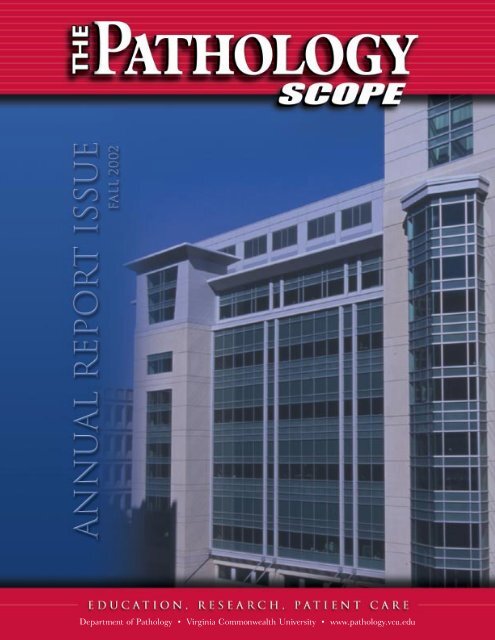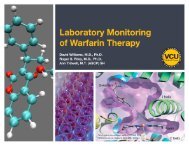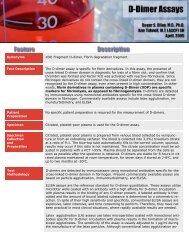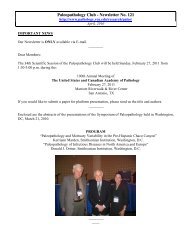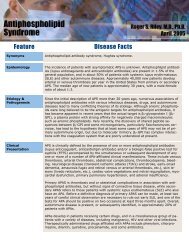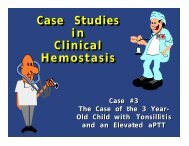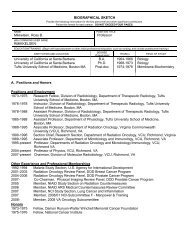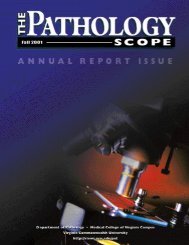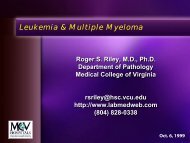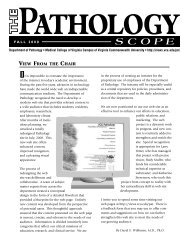232736-MCV Pathology Report - Pathology - Virginia ...
232736-MCV Pathology Report - Pathology - Virginia ...
232736-MCV Pathology Report - Pathology - Virginia ...
You also want an ePaper? Increase the reach of your titles
YUMPU automatically turns print PDFs into web optimized ePapers that Google loves.
Department of <strong>Pathology</strong> • <strong>Virginia</strong> Commonwealth University • www.pathology.vcu.edu
View From the Chair<br />
This special edition of the <strong>Pathology</strong> Scope represents our second Annual <strong>Report</strong> issue. We wish to share with<br />
our employees, colleagues, and friends the many successes we have enjoyed as a large, diverse clinical department<br />
during the past year. It is especially remarkable that we have prospered and grown in an extremely difficult financial<br />
climate. The strides that we have made reflect the determination of a highly talented faculty and staff. Our people<br />
repeatedly find creative solutions to complex challenges. Time and time again, they have risen to the challenge,<br />
finding new ways to raise revenues and reduce costs. We have enjoyed continued success in the areas of teaching,<br />
patient care, and research. Several of our faculty members once again earned recognition from the School<br />
of Medicine for excellence in teaching. We graduated an outstanding class of residents and fellows, and we recruited<br />
an equally talented new group of trainees. We have been leaders in the use of web-based education, and we may<br />
rightfully boast that ours is among the finest academic pathology websites in the nation. Our brand new clinical<br />
laboratories in the Gateway Building improve our ability to respond to the needs of the patients and physicians of<br />
the VCU Health System. These labs benefit our employees by providing a state-of-the-art working environment.<br />
Grant funding for our scientific programs continues to increase along with our published research. Our faculty and<br />
managers play key roles in the governance of local, national, and international pathology organizations. Each passing<br />
year, we set new standards for excellence in the performance of our stated mission “to provide high-quality, costeffective<br />
pathology services in a manner that supports the patient care, education, and research missions of the VCU<br />
Health System and the <strong>Virginia</strong> Commonwealth University School of Medicine”. Employees at every level of the<br />
Department of <strong>Pathology</strong> deserve credit and recognition for their contributions to this continued success.<br />
David S. Wilkinson, MD, PhD<br />
Professor and Chairman<br />
Strategic Planning UPDATE<br />
On March 26, 2002, a group of thirteen faculty and<br />
managers (Dave Wilkinson, Carl Garrett, Celeste<br />
Powers, Richard McPherson, Greg Miller, Tom Dilts,<br />
Jeff Casterline, Ann Harris, Margaret Grimes, Sue<br />
Roseff, Andrea Gonzalez, Roxanne Golden, and Larry<br />
Vetter) met in an off-campus retreat to discuss strategic<br />
planning issues relevant to the clinical enterprise of<br />
the Department of <strong>Pathology</strong>. The objective of this<br />
meeting was to recommend ways to enhance the<br />
department’s delivery of clinical laboratory services<br />
by identifying problems to solve and opportunities<br />
to pursue.<br />
The ultimate product of this small group was a concise<br />
list of high-impact, realistically achievable initiatives.<br />
These initiatives will serve as the Department of<br />
<strong>Pathology</strong>’s Strategic Plan for Clinical Service. A planning<br />
horizon of eighteen months was used. The environment<br />
in which we operate is dynamic and rapidly<br />
changing. Finances, technology, reimbursement, and<br />
standards of care are in a constant state of flux.<br />
Planning must occur in a timeframe that reasonably<br />
accommodates environmental change. Therefore, an<br />
eighteen month horizon is realistic and manageable for<br />
planning purposes. The planning group’s recommendations<br />
were delivered to all faculty and lab managers<br />
at a dinner meeting held on August 6th in the Medical<br />
Sciences Building. The large group participated in a<br />
focused review and discussion of the initiatives, which<br />
will become operational in the coming weeks.<br />
This round of planning was modeled on the department’s<br />
research planning process in 2001 that resulted<br />
in the current Strategic Plan for Research. The roster<br />
of participants was carefully chosen to ensure that<br />
executive leadership and practical experience from<br />
across all functional areas of the department was represented.<br />
Members of the Department of <strong>Pathology</strong><br />
may request copies of the Strategic Plans for Clinical<br />
Service and Research by contacting Larry Vetter,<br />
Director of Strategic Planning and Development, at<br />
828-3870.<br />
• 1 •
ADMINISTRATOR’S CORNER<br />
The Department of <strong>Pathology</strong> ended the last<br />
fiscal year on a positive note. Our budget for<br />
fiscal year 2002 projected that we would end<br />
the year on a breakeven basis. In fact, we<br />
were able to realize a small surplus of funds<br />
that we will sorely need in the fiscal years to<br />
come.<br />
In many ways this past year was devoted to<br />
reconstruction of the administrative office.<br />
Staff responsibilities were modified. New<br />
reporting methods were under development.<br />
New software was acquired to<br />
enhance and expand the administrative<br />
staff’s working strengths. Additionally,<br />
nearly all administrative staff members<br />
received specialized training during the year<br />
to move them to a higher level of expertise<br />
and knowledge. All of this was done to<br />
improve customer service and to be more<br />
responsive to the needs of the faculty and<br />
the technical staff.<br />
As you know, nearly all sources of funding<br />
for this department are under stress. The<br />
Commonwealth of <strong>Virginia</strong> has reduced our<br />
operating support by nearly 10% for the current<br />
fiscal year. The money we receive from<br />
the hospital has decreased for the last two<br />
years and we see no sign of that changing.<br />
Clinical receipts remain flat as Medicare and<br />
the managed care payors reduce their payments<br />
to us while our work volume is<br />
increasing.<br />
It remains unclear at this time what the<br />
impact of The Hunter Group consultant<br />
review and medical center reorganization<br />
will be on this department. Whatever that<br />
impact, the challenge facing us as a clinical<br />
department will be to provide the best service<br />
we can to our patients, faculty, and staff<br />
during a period of diminishing resources.<br />
The work that we have undertaken in this<br />
past fiscal year to enhance and develop our<br />
administrative operations will help us in this<br />
challenge. The fruits of these efforts will be<br />
visible as we progress in the new fiscal year.<br />
Jeffrey L. Casterline<br />
Administrator<br />
OVERALLAccomplishmentsOVERALL<br />
For Fiscal Year 2002<br />
• The Cerner LIS is now a fully functional tool for clinical<br />
testing and specimen processing. The Health System<br />
places increasing trust and reliance upon our experience<br />
as it moves closer to implementing the Cerner<br />
Millennium Clinical Information System.<br />
• Our faculty continues to be extremely productive in<br />
academics, providing a total of 976 contact hours<br />
in formal courses and 1225 additional lecture contact<br />
hours in the school of medicine. Their scholarly productivity<br />
included 69 peer-reviewed publications, 19 book<br />
chapters, and 66 abstracts. They served on 29 editorial<br />
advisory boards and peer-reviewed 520 manuscripts.<br />
• We continue to engage the<br />
executive management of<br />
the Department in an<br />
ongoing Strategic Planning<br />
Program that most recently<br />
developed a comprehensive<br />
Strategic Plan for Clinical<br />
Service.<br />
• The <strong>Pathology</strong> web page<br />
continues to improve, and<br />
it is among the finest academic<br />
pathology websites<br />
in the country.<br />
EDUCATIONAL Accomplishments<br />
• Medical School, Dental School, and Physical Therapy<br />
teaching materials are being continuously upgraded in<br />
the teaching labs.<br />
• Our residency program filled all four PGY1 positions in<br />
the match with U.S. graduates.<br />
• We established a Resident Award for Excellence in Clinical<br />
<strong>Pathology</strong> Service.<br />
• Five faculty members were honored this year by the VCU<br />
School of Medicine for excellence in teaching medical<br />
students.<br />
• 2 •
RESEARCH Accomplishments<br />
• Funded research projects with direct and indirect costs of $1,706,563 were in progress last year.<br />
• Shawn Holt was awarded a grant for “Molecular Mechanisms of Prostate Cancer Progression”. The project, in the<br />
amount of $350,000 for three years, was funded by the Department of Defense Prostate Cancer Research Program.<br />
The goal of the study is to elucidate the mechanism of tumorigenic transformation in prostate cancer cells.<br />
• Alphonse Sirica was awarded a Merck Research Grant in the amount of $50,000 to investigate cyclooxygenase-2 in<br />
human and rat biliary carcinogenesis.<br />
• Joy Ware earned a four-year competitive renewal of her NIDDK grant “Regulation of Prostate Epithelial Cell<br />
Growth”. Total funding for the project is $930,290.<br />
• Carleton Garrett has taken a leadership role in the <strong>Virginia</strong>’s Commonwealth Technology Research Fund (CTRF)<br />
project grant, which will provide 1 million dollars per year for three years to evaluate gene expression and genetic<br />
changes in human brain, ovarian, breast, and hemolymphocytic cancers.<br />
• The Functional Genomics program continues to grow under Joy Ware’s leadership, and is using MALDI Mass<br />
Spectrometer to conduct high-throughput analysis of proteins, lipids, and other molecular entities.<br />
• In February, 2002 we began holding monthly research luncheons to provide our<br />
faculty with a regular forum for collegiality and interaction. The event brings<br />
together faculty members from across all academic and clinical areas of the<br />
department to share lunch and research interests. Each month, a<br />
different faculty member shares topics that focus on techniques,<br />
issues and research that are of interest to the larger faculty.<br />
CLINICAL SERVICE<br />
Accomplishments<br />
• Successful relocation of the Surgical <strong>Pathology</strong> and Transfusion Medicine Services<br />
to the 6th floor of the new Gateway Building.<br />
• Laboratory support was increased to meet the expanding needs of the Oncology Clinic at Stony Point.<br />
• We successfully implemented a conversion of the Cerner Blood Bank Millennium laboratory information system.<br />
• The Cytopathology Lab now offers the Autocyte PREP liquid based monolayer technology as an alternative to the<br />
conventional pap smear. Autocyte’s enrichment process and differential centrifugation help eliminate obscuring<br />
material and increase the concentration of abnormal cells.<br />
• The Histology Lab began using the Artisan Staining System by Cytologix. This is the latest generation of staining<br />
automation, providing the flexibility of manual staining coupled with the precision and consistency of automation.<br />
• Molecular Diagnostics expanded its testing capabilities in some very important areas: FISH (fluorescent in-situ<br />
hybridization) testing for Her-2/neu in breast cancer; T-cell monoclonality by PCR uses PCR with capillary<br />
electrophoresis (CE) to detect monoclonal populations of T-cells in a background of lymphocytes; Factor II<br />
(prothrombin) G20210A detects a polymorphism in the factor II gene which leads to hypercoagulability, which can<br />
cause deep vein thrombosi, and pulmonary embolism.<br />
• A new lab section was created within the chemistry and specimen processing area to provide STAT testing for<br />
specific chemistry and hematology procedures. The lab will support all areas of the hospital, especially the<br />
Emergency Department and intensive care areas. This “Ultra STAT” lab has significantly reduced turn around<br />
time for time-sensitive laboratory results.<br />
• Laboratory staffing retention program was instituted resulting in a 50% decrease in staff turn over and decreased vacancies.<br />
• Coordinated and developed a written protocol for the new Translogic pneumatic tube system.<br />
• 3 •
• Assisted in the development of the hospital bio-terrorism plan.<br />
• Successfully negotiated below budget ($100,000) and budget neutral contracts for new immunochemistry<br />
and coagulation instrumentation.<br />
• Relocated outpatient phlebotomy services to the Gateway Building.<br />
• Developed phlebotomy support for the outpatient-testing center in the Ambulatory Care Center.<br />
• Trained phlebotomists in EKG’s to temporarily cover in cardiology in the outpatient-testing center in Nelson.<br />
• Continued consolidation of Chemistry and Toxicology.<br />
• Established contracts to serve as primary toxicology reference lab for the Commonwealth of <strong>Virginia</strong> Driving<br />
Under the Influence of Drugs program, with projected revenue of $200,000 per year.<br />
• Implemented flexible scheduling of staff in some areas of department.<br />
• Purchased an irradiator in Transfusion Medicine Service saving $120,000 per year in irradiation expense.<br />
• Renegotiated a culture media contract for savings of $43,000 per year.<br />
• Collaborated with the OR for the successful building of a new OR laboratory, with Coagulation testing and<br />
Central Blood Bank product storage and dispersing in the OR, in addition to Blood Gas Analysis.<br />
OVERALL GOALS For Fiscal Year 2003<br />
• The Department of <strong>Pathology</strong> will provide high-quality, cost-effective pathology services in a manner<br />
that supports the patient care, research, and education missions of the VCU Health System and the<br />
<strong>Virginia</strong> Commonwealth University School of Medicine.<br />
• The Department will maintain an ongoing Strategic Planning Program, continually engaging senior<br />
leaders to develop creative strategies in the critical areas of education, research, clinical service, and<br />
administration.<br />
• We will utilize the most current technological advancements to educate<br />
residents and medical students.<br />
EDUCATIONAL GOALS<br />
Our goals in the area of education are to:<br />
• Upgrade digital imaging and computer-based learning.<br />
• Create rotation-specific objectives, skills checklists, pre- and post-tests, case-based tutorials, didactic teaching methods,<br />
advanced rotations in specialty areas, and feedback mechanisms.<br />
• Optimize performance in the resident match and attract an increased number of qualified resident applications.<br />
• Expand and develop use of the internet for teaching.<br />
• Develop a resident assistant lab director program.<br />
• 4 •
CLINICAL SERVICE<br />
GOALS<br />
• Continually improve the effectiveness of teaching on rotations.<br />
• Consolidate vendor relationships.<br />
• Use more of capital equipment leases and reagent rental<br />
agreements.<br />
• Automate front-end specimen management.<br />
• Improve utilization control.<br />
• Develop a better understanding of physician ordering patterns.<br />
• Decrease the volume of ICU testing.<br />
• Decrease the volume of expensive esoteric testing.<br />
• Decrease the volume of send outs.<br />
• Use information systems to improve operational efficiency.<br />
• Increase informatics skill of existing personnel (faculty and staff).<br />
• Improve the use of Cerner management reports.<br />
• Improve billing effectiveness.<br />
• Improve compliance training.<br />
• Appoint a billing expert for each lab section.<br />
• Improve faculty access to reimbursement information.<br />
• Increase front end registration training.<br />
• Improve reimbursement for Anatomic <strong>Pathology</strong> consult<br />
services.<br />
• Increase Outreach volume.<br />
• Increase marketing of “niche” specialties.<br />
• Collect 100% of negotiated fees on all contracts.<br />
• Maintain charge master on a routine basis.<br />
• Automate charge master maintenance.<br />
• Deploy Retention/Recruitment plan within twelve months.<br />
• Develop a career ladder for all employees.<br />
• Create more opportunity for internal staff to provide<br />
continuing education presentations.<br />
• Calculate the real cost of staff turnover and demonstrate<br />
how it affects revenue stream<br />
• Improve customer service by standardizing communication,<br />
acknowledging receipt of specimens, and proactively work<br />
ing with Client Services in “special” circumstances.<br />
• Cross train surgical pathology and client services personnel.<br />
• Develop a reference laboratory interface for Cerner LIS.<br />
• Utilize Path Links dial-in functionality for Outreach<br />
customers to access lab results.<br />
RESEARCH GOALS<br />
• Maintain a collaborative environment within<br />
<strong>Pathology</strong>.<br />
• Improve infrastructure to facilitate research.<br />
• Educate clinically oriented faculty and residents<br />
in research and grantsmanship techniques.<br />
• Give priority to research potential in faculty<br />
recruitments.<br />
• Provide leadership for the Cancer Genomics<br />
Initiative.<br />
Progress in all areas will be made through the<br />
thoughtful and deliberate approach to problem<br />
solving in a collaborative environment.<br />
• 5 •
<strong>Pathology</strong> Residency Program Update<br />
T<br />
he department’s Graduate Medical Education<br />
Programs continue to draw talented graduates from<br />
respected educational institutions. The professional,<br />
collegial atmosphere that we create and the excellent<br />
educational opportunities that we provide distinguish<br />
our programs. Each year, the department hosts a<br />
graduation banquet to honor those trainees finishing<br />
residencies, fellowships, and doctoral programs. On June<br />
6, 2002, members of the department gathered at the<br />
Capital Club to acknowledge those who were leaving the<br />
department and those staying on with the department in<br />
new capacities after finishing their educational<br />
programs. It is at this event that the we traditionally<br />
recognize outstanding contributions to our educational<br />
mission. This year, five awards were bestowed:<br />
• Fergus O’M. Shiel Resident Teaching Award -<br />
Michelle Riddick-Young, MD (PGY-4)<br />
• Charles W. “Buck” Moncure Autopsy Service Award -<br />
Mary Jo Martin, MD (PGY-4)<br />
• Saul Kay Faculty Appreciation Award -<br />
Kristen Atkins, MD (Assistant Professor)<br />
• Resident Research Award -<br />
Shawn Zhao, MD (PGY-2)<br />
• Clinical <strong>Pathology</strong> Award -<br />
Richard Hermann, MD (PGY-2)<br />
The banquet honored those who were completing their<br />
training and moving on, here or elsewhere. Honorees<br />
were:<br />
• John Fernandes, MD finished his fellowship in<br />
Forensic <strong>Pathology</strong> and is now a Medical Examiner<br />
with the Hamilton Health Science Center in Hamilton,<br />
Ontario.<br />
• Matt Foster, MD finished his fellowship in<br />
Cytopathology and is now in private practice in<br />
Lynchburg.<br />
• Cindy Lindsey, MD finished her fellowship in<br />
Cytopathology and is taking time off to attend to her<br />
expanding family before returning to practice fulltime.<br />
She and her family live in Williamsburg.<br />
• Anna O’Grady, MD finished her fellowship in<br />
Molecular Diagnostics and is now a fellow in the<br />
Cytopathology Section of the National Institutes of<br />
Health in Bethesda, Maryland.<br />
• Juan Perez-Berenguer, MD will finish his<br />
fellowship in Neuropathology in December, 2002.<br />
• Rob Forsythe, MD finished his residency in<br />
Anatomic and Clinical <strong>Pathology</strong> and is now a Surgical<br />
<strong>Pathology</strong> Fellow at the George Washington University<br />
in Washington, D.C.<br />
• 6 •<br />
• Rajat Goel, MD finished his residency in Anatomic<br />
and Clinical <strong>Pathology</strong> and is now a Cytopathology<br />
Fellow with our department.<br />
• C. Lee Bridges, MD finished his residency in<br />
Anatomic and Clinical <strong>Pathology</strong> and is now a<br />
Cytopathology Fellow with our department.<br />
• Soni Anderson, MD, PhD finished her residency<br />
in Clinical <strong>Pathology</strong> and is now continuing her<br />
scientific career in the Washington, D.C. area.<br />
• Christopher Kenney, PhD was recognized for<br />
completing his doctorate and is now a first year<br />
medical student in the VCU School of Medicine.<br />
The Department is also pleased to welcome new<br />
residents and fellow who began their training with<br />
us on July 1st. They are:<br />
• Bradly Clark, MD - Molecular Diagnostics Fellow<br />
(AP Residency at NIH ‘02)<br />
• Deborah Armstrong, J.D., MD - AP/CP Resident<br />
(<strong>Virginia</strong> Commonwealth University ‘02)<br />
• Toby Gray, MD - AP/CP Resident<br />
(University of Texas at San Antonio ‘02)<br />
• Daniel Klink, MD - AP/CP Resident<br />
(Indiana University ‘02)<br />
• Erin Thibault, MD - AP/CP Resident<br />
(Louisiana State University ‘02)<br />
This year’s welcome picnic for faculty and housestaff,<br />
scheduled for October 5th at Deep Run Park in Henrico<br />
County, was organized by Chief Residents Christine<br />
Cesca, MD and Michelle Riddick-Young, MD<br />
Drs. Nitya Ghatak and Charles Moncure present the<br />
Moncure Autopsy Service Award to Mary Jo Martin, M.D.
BILLED TESTS<br />
PERSPECTIVES<br />
Laboratory<br />
As noted in our list of accomplishments, we have had a very<br />
exciting and successful year. The move of the Transfusion<br />
Medicine Services and Surgical <strong>Pathology</strong> to the Gateway<br />
Building is just one of our major strategic actions to move us<br />
forward as a department. We have had a good year financially<br />
in terms of controlling expenses and growing our outreach<br />
program. We continue to face the challenge of decreasing<br />
reimbursements, which is offset by revenue brought in by the<br />
Outreach Program.<br />
We have a great laboratory operation because we have great<br />
staff. This past year we developed an employee retention program<br />
that has helped reduce vacancies and turnover in the clinical<br />
laboratories. People are our most important resources, and<br />
we are committed to supporting and growing our staff. The<br />
Department of <strong>Pathology</strong> and the School of Clinical Laboratory<br />
Sciences are working together to develop educational career<br />
ladders that allow qualified staff to obtain a medical laboratory<br />
technician certification and/or medical laboratory technologist<br />
certification while working part or full time. Additionally, the<br />
department is finalizing an RFP for new automated instrumentation<br />
for Chemistry/ImmunoChemistry/Toxicology/<br />
Hematology. These are just two of some exciting things<br />
happening for this present fiscal year as we look forward to<br />
additional challenges and opportunities. The graphs to the<br />
right illustrate our performance in key areas during the<br />
past year.<br />
Thomas Dilts<br />
Director of Laboratory Operations<br />
PERSONNEL<br />
RATIOS<br />
REVENUE AND EXPENSES<br />
Laboratory Information System Progress<br />
When implementation of the VCUHS Cerner Millennium<br />
system is complete, the department’s PathNet LIS product<br />
will be merging with the new Cerner Millennium hospital<br />
clinical applications (physician activities, nursing activities,<br />
Emergency Department, Pharmacy, Dietary, Medical<br />
Records). This merge will result in a single integrated<br />
information system with a shared electronic medical record<br />
for most clinical care areas. The PathNet functions will<br />
continue to support laboratory activities, but will be fully<br />
integrated into the clinical care enterprise. The preparation<br />
and testing for this merge has been the major focus of LIS<br />
and HIS, activities for the past two years. The VCUHS<br />
Cerner system should be implemented in the near future<br />
and will enable a new era in integrated information<br />
management. Greater access to clinical information will<br />
help <strong>Pathology</strong> to better manage the delivery of laboratory<br />
medicine and diagnostic services. Access to more<br />
comprehensive data will also support clinical outcomes<br />
research and further improve our patient care activities.<br />
In preparation for the merge, PathNet LIS installed a major<br />
code revision in August that will enable several new features<br />
to be implemented in the year ahead. Image capture during<br />
case review and signout for Anatomic <strong>Pathology</strong> will allow<br />
the electronic medical record to include morphologic<br />
documentation of cases. Selected diagnostic images can be<br />
added to the report, and images can be organized for<br />
conference and teaching purposes. Autoverification for online<br />
instruments is a new feature to improve efficiency in the<br />
general laboratory area. Microbiology now includes on-line<br />
epidemiology review, new reporting capability, and<br />
enhanced antibiogram capabilities. Microbiology also has a<br />
redesigned result entry application that allows full paperless<br />
processes. Outreach now has a new web based orders and<br />
results functionality which will enhance our competitiveness<br />
for outreach business.<br />
• 7 •
The <strong>Pathology</strong> Outreach Program Continues to Grow<br />
The <strong>Pathology</strong> Outreach Program continues to add infrastructure as the volume of referrals and net contributions<br />
to the health system increases each year. During FY2002, the program expansion included:<br />
▲ ▲ ▲ ▲ ▲ ▲<br />
Creation of a Team Leader position in Outreach Specimen Processing<br />
Expanded hours of coverage in Processing<br />
Three Senior Phelbotomists were hired to provide coverage for Long Term Care clients in the area, and perform<br />
Paternity collections to support the Human Identity testing offered by the Molecular Diagnostics Division.<br />
Two Service Representatives (couriers) are available to pick up and deliver samples from local customers from 7 AM<br />
to 8PM daily.<br />
In the area of Sales, a second Sales Representative and a Sales Support Representative have been added to handle<br />
Clinical Trials and research activities.<br />
A third vehicle has been added to support the Outreach for sales and courier service.<br />
Marketing Focus:<br />
The Marketing and Sales effort primarily targets customers whose needs closely match the scope of services<br />
provided in our Clinical, Anatomic, and Molecular divisions, with special emphasis on boutique services<br />
including Dermatopathology, Hemostasis, Infectious Disease, Flow Cytometry, Paternity Testing, and Renal<br />
<strong>Pathology</strong>. The Outreach team is building a statewide laboratory network to allow community based laboratory<br />
services to respond to public sector and managed care bids.<br />
FY02 Growth Experience:<br />
Growth over the past three years has been modest, while working through<br />
the Cerner Millennium installation and the current Cerner Information<br />
System (CIS) project for the VCUHS enterprise. Once the new CIS goes<br />
live, Outreach intends to pull out the stops and move forward at a more<br />
aggressive pace. The attached graph demonstrates the continued success<br />
of the program at VCUHS.<br />
Future Enhancements:<br />
The program’s business plan is a moving target, trying to project volume<br />
and revenue growth and laboratory infrastructure needs by looking forward in three year increments.<br />
Science Museum of <strong>Virginia</strong> Mini-Medical School<br />
T<br />
he Fall 2002 term of the Mini-Medical School,<br />
sponsored by the Science Museum of <strong>Virginia</strong> and<br />
VCU, is co-directed by Eugene G. Maurakis, PhD,<br />
museum scientist, and David S. Wilkinson, MD, PhD,<br />
Chairman of the Department of <strong>Pathology</strong>. The<br />
theme of the Fall program is “<strong>Pathology</strong>: Linking<br />
Technology With Good Health”. Eight faculty members<br />
in the Department of <strong>Pathology</strong> will be featured<br />
speakers, presenting the latest information about the<br />
causes, diagnoses, and treatments of serious conditions<br />
including blood clots, cervical cancer, stroke,<br />
Alzheimer’s disease, renal failure, and breast<br />
cancer. All sessions will meet on Wednesdays,<br />
September 18th through November 6th from 7 to<br />
9pm in the Ethyl Corporation IMAX Dome at the<br />
Science Museum of <strong>Virginia</strong>. Information and registration<br />
are available online at www.smv.org. This<br />
program is free and open to the public.<br />
• 8 •
A<br />
Clinical Laboratories Open in the Gateway Building<br />
fter considerable planning and preparation, the Surgical <strong>Pathology</strong>, Cytopathology, and Transfusion<br />
Medicine clinical laboratories relocated to custom-designed space in the Gateway Building in June. This<br />
represents a major improvement in our physical plant, in terms of usable square footage, functionality of<br />
space, proximity to the operating rooms, and work environment. Design work was done by the certified<br />
laboratory architectural firm Mortland Planning and Design, with a great deal of practical input from our<br />
service directors and laboratory managers.<br />
As construction progressed, Debbie Reynolds served as project coordinator for the Department of <strong>Pathology</strong>.<br />
Debbie played a key role in ensuring that regular communication was maintained among the architects,<br />
contractors, and laboratories. Jill Sheek, Manager of Transfusion Medicine and Judy Luck, Manager of<br />
Anatomic <strong>Pathology</strong>, were actively involved in the planning, design, and relocation activities. Their long and<br />
tireless efforts were essential, and helped the project move forward smoothly. Mike Langley, Manager of<br />
Molecular Diagnostics, was extremely helpful in an advisory capacity. He brought experience to the project,<br />
having overseen the MDx lab construction the previous year. Rudy Muller, Cheryl Ross, and Gael Harman<br />
provided critical support in the seamless relocation of computers and networks.<br />
During the move, there was no service interruption. The fact that a move of<br />
this complexity was transparent to the patients and physicians of the Health<br />
System is a minor miracle, and a tribute to the dedication of the staff, who<br />
worked evenings and weekends until the move was complete. All of our<br />
clinical laboratories are now situated in thoroughly modern locations.<br />
According to Dr. Jack Frable, who served for many years as the Director of<br />
Surgical <strong>Pathology</strong> in Sanger Hall, “Our space in Gateway is well designed,<br />
consistent in temperature and humidity, light, airy and really a joy to work in.<br />
The new lab space is a vast improvement from the conditions in Sanger Hall.<br />
A few days after we moved in, I had to go back to Sanger for some reason. It<br />
was hard to imagine that we were in there for 36 years, and Dr. Kay for 42<br />
years. The old labs were hot, poorly ventilated, and cramped. I think<br />
everyone is very happy with Gateway, and the few odd things that always<br />
crop up with new construction have been minor. All of the faculty,<br />
technologists, transcriptionists, residents, and fellows who produced such<br />
consistently high-quality work during four decades in the less than ideal<br />
clinical space of Sanger Hall should be commended.” A gallery of Dr. Frable’s<br />
artwork hangs in the Gateway 6 office corridor, and Dr. Kay’s portrait has been<br />
permanently mounted in the elevator lobby.<br />
Dr. Susan Roseff, Director of Transfusion Medicine, sees the<br />
central location as the greatest advantage. “It is much easier for<br />
the patients and doctors to reach the apheresis area now. The<br />
OR and the main hospital are very close in proximity. The work<br />
area is bright and uplifting, with a beautiful view of the city from<br />
the south hallway. Communication among the staff is also easier<br />
with this open design. In the A.D. Williams building, we were<br />
closed off from each other in many small rooms.”<br />
“This relocation was a long time in coming. Through significant<br />
planning and a major commitment of resources by the<br />
department and the Health System, we have built a clinical space<br />
that we can all be proud of,” said Dr. David Wilkinson, Chairman<br />
of <strong>Pathology</strong>. “Our productivity, recruitment, and staff morale<br />
are sure to be positively impacted in the coming years.”<br />
• 9 •
PATHOLOGY<br />
GRAND ROUNDS<br />
<strong>Pathology</strong> Grand Rounds are held every Friday at noon during the academic year in Sanger Hall 4-026. This<br />
Fall, we offer a diverse roster of presenters speaking on a variety of topics relevant to academic pathology.<br />
All are welcome.<br />
September 6th<br />
Roger S. Riley, MD, PhD, Associate Professor<br />
VCU Department of <strong>Pathology</strong><br />
Thromboembolic Disease: Recent Advances in<br />
Diagnosis and Treatment<br />
September 13th<br />
Shirley M. Taylor, PhD, Associate Professor<br />
VCU Department of Microbiology & Immunology<br />
Regulation of DNA Methylation in Normal and<br />
Neoplastic Cells<br />
September 20th<br />
Lauren S. Gollahon, PhD, Assistant Professor<br />
Texas Tech University<br />
Department of Biological Sciences<br />
Detection of HPV Infected Cervical Cells<br />
Using Nanotechnology<br />
September 27th<br />
W. Greg Miller, PhD, Professor<br />
VCU Department of <strong>Pathology</strong><br />
An Integrated Clinical Informatics System to<br />
Enable Outcomes Research<br />
October 4th<br />
Lawrence Povirk, PhD, Professor<br />
VCU Department of Pharmacology & Toxicology<br />
Repair of DNA Double-Strand Breaks with Damaged<br />
Ends by Nonhomologous End Joining<br />
October 11th<br />
Suzanne Barbour, PhD, Associate Professor<br />
VCU Department of Microbiology & Immunology<br />
The Role of Calcium-Independent PLA2 in<br />
Cell Physiology<br />
October 18th<br />
Chris Lehman, MD, Associate Professor<br />
University of Utah Health Sciences Center Department<br />
of <strong>Pathology</strong><br />
Clinical Validation of the ADVIA 120 Hematology<br />
Analyzer: Impact on Hematology Testing<br />
October 25th<br />
David Shafritz, PhD, Professor<br />
Albert Einstein College of Medicine of Yeshiva<br />
University<br />
Department of Medicine<br />
Stem Cells and the Liver: Fact or Fiction?<br />
November 1st<br />
Sarah Spiegel, PhD, Professor & Chair<br />
VCU Department of Biochemistry and Biophysics<br />
The Many Hues of Sphingosine-1-Phosphate<br />
November 8th<br />
Mark Brecher, MD, Professor & Director of<br />
Transfusion Medicine Services<br />
University of North Carolina at Chapel Hill<br />
Department of <strong>Pathology</strong> & Laboratory Medicine<br />
Bacterial Contamination of the Blood Supply<br />
November 15th<br />
Young Chen, PhD, Associate Professor<br />
Wake Forest University School of Medicine<br />
Department of Cancer Biology<br />
DCC: To Be or Not To Be a Tumor Suppressor<br />
November 22nd<br />
Joy Ware, PhD, Professor<br />
VCU Department of <strong>Pathology</strong><br />
The Network Paradigm and Prostate Cancer Growth<br />
Control<br />
December 6th<br />
Andrea Ferreira-Gonzalez, PhD, Associate Professor<br />
VCU Department of <strong>Pathology</strong><br />
TBA<br />
December 13th<br />
Greg Hannon, PhD, Associate Professor<br />
Cold Spring Harbor Laboratories<br />
Mechanisms of RNA<br />
• 10 •
Modernization of the Autopsy Suite<br />
The Department of <strong>Pathology</strong> first occupied the<br />
Autopsy Suite on the second basement level of Sanger<br />
Hall almost 40 years ago. The facilities were state of the<br />
art at that time. After 40 years of use, the original<br />
autopsy space is being renovated in four planned phases.<br />
Each phase will include modern equipment and<br />
improvements. Phase I of the renovation began just<br />
over a year ago in the main autopsy room. All of the<br />
old autopsy tables were removed and the first of two<br />
new stainless steel stations was installed. The ceiling<br />
was painted glossy white and new lighting added<br />
brightness to the rooms. The ventilation system was<br />
cleaned and improved. The old office ceiling tiles were<br />
also replaced. Phase II of the upgrade will include<br />
improvements in the isolation room. A new stainless<br />
steel autopsy table will replace the current table. A<br />
redesign of office space to provide report storage and a<br />
reference library for use by residents and staff is also<br />
planned. Phase III calls for the installation of a second<br />
stainless steel autopsy station and new stainless steel<br />
cabinets in the main suite. Phase IV will conclude with<br />
the installation of a waterproof, crack free, non-skid<br />
epoxy floor. The improved physical appearance and<br />
upgrades improve workflow, working conditions, and<br />
staff morale of the autopsy service.<br />
National CLMA/ASCP<br />
Conference & Exhibition<br />
Five members of the Department of <strong>Pathology</strong> were<br />
speakers at the International Clinical Laboratory<br />
Management Association Conference & Exhibition<br />
held in New Orleans in June. The presentations by our<br />
team included the following:<br />
• Zoom, Zoom, Zoom: Outreach Courier Services -<br />
From A Dream to Reality, Ann Harris, MT(ASCP),<br />
Outreach Program Manager<br />
• The Manager’s New Role as Retention Officer, Tom<br />
Dilts, MBPA, MT(ASCP), Director of Laboratory<br />
Operations<br />
• Using Benchmarking to Manage Your Lab, David S.<br />
Wilkinson, MD, PhD, Chairman Department of<br />
<strong>Pathology</strong> & Deborah Reynolds, MT(ASCP), Special<br />
Projects Coordinator<br />
• Strategic Business Planning: A Template for Analysis,<br />
Ann Harris, MT(ASCP), Outreach Program Manager,<br />
& Johnetta Balk, MT(ASCP)SBB, Outreach<br />
Marketing & Sales Specialist<br />
• Maximizing Your Marketing Dollars: A Creative<br />
Marketing Networking Idea Exchange, Johnetta W.<br />
Balk, MT(ASCP)SBB, Outreach Marketing & Sales<br />
Specialist<br />
A<br />
Honors for the Clinical<br />
Laboratory Science Program<br />
t the annual meeting of the American<br />
Society for Clinical Laboratory Science held in<br />
Orlando, Florida, a faculty member and two<br />
students in the Clinical Laboratory Science<br />
program at VCU were honored. Michelle<br />
Siggelakis, a senior student in the baccalaureate<br />
Clinical Laboratory Sciences program, was<br />
awarded the Ruth M. French Memorial<br />
Scholarship. Ms. Siggelakis obtained her MLT<br />
associate degree from J. Sargeant Reynolds<br />
Community College in May 2001 and began<br />
working in the clinical laboratory at Bon Secours’<br />
St. Mary’s Hospital. She was, however,<br />
committed to furthering her education and<br />
entered the CLS baccalaureate program at VCU<br />
where she has excelled academically. In addition<br />
to her work and school responsibilities she has<br />
volunteered her services in the community,<br />
working for the Fan Free Clinic and the <strong>MCV</strong><br />
Children’s Medical Center. Also during the<br />
ASCLS Annual Awards ceremony, Teresa Nadder<br />
and Mike Langley were recognized with a CLS<br />
Distinguished Author Award for their article<br />
entitled, “The New Millennium Laboratory:<br />
Molecular Diagnostics goes Clinical”. Dr. Nadder<br />
is the Assistant Chairman of the Department of<br />
Clinical Laboratory Sciences at VCU. Mr.<br />
Langley is the manager of the Molecular<br />
Diagnostics laboratory at VCUHS and a student<br />
in the Master of Science program in the<br />
Department of Clinical Laboratory Sciences.<br />
• 11 •
Molecular Diagnostics<br />
The faculty and staff of Molecular Diagnostics, in<br />
collaboration with the Department of Clinical<br />
Laboratory Science, will offer a new graduate level<br />
course called “Introduction to Molecular<br />
Diagnostics”. This class will be offered for the first<br />
time in the Fall of 2002.<br />
Several new tests have been added to the Molecular<br />
Diagnostics menu during the past year. These tests<br />
are in addition to an already extensive menu of tests.<br />
• Factor II (prothrombin) G20210A polymorphism<br />
• T-cell monoclonality by PCR<br />
• Prader-Willi/Angelman syndrome<br />
• Her2-neu amplification by FISH<br />
• Quantitation of t(9;22) by Real Time RT-PCR<br />
The MDx lab has entered into an agreement to be the<br />
national referral center for Fragile X Syndrome and<br />
Prader Willi/Angelman Syndrome testing for Esoterix<br />
Laboratories. In addition, work has been completed<br />
for the clinical trial “Clinical evaluation of the HCV<br />
RNA qualitative assay for use in the diagnosis of subjects<br />
at risk for or suspected of having hepatitis C<br />
infection”. This clinical trial was supported by<br />
GenProbe, Inc.<br />
Phlebotomy - Where Quality Begins<br />
The phlebotomist is often the only laboratory<br />
employee a patient sees. Acting as the “face” of the<br />
laboratory, the phlebotomist must create a<br />
professional atmosphere of trust and confidence<br />
when interacting with patients. Calming fearful<br />
patients and dealing with difficult customers is all in<br />
a day’s work. Phlebotomists often work without<br />
direct supervision. They must like challenge and<br />
responsibility, be accurate, pay attention to detail,<br />
work well under pressure and have good<br />
communication skills. The Department of <strong>Pathology</strong><br />
has an experienced and talented group of<br />
phlebotomists who provide phlebotomy services at<br />
the following locations on the VCUHS campus, at<br />
satellite locations, and for our Outreach customers:<br />
◆ Gateway Building 1st floor<br />
◆ Ambulatory Care Center,<br />
2nd floor, 3rd floor, 4th floor<br />
◆ Nelson Clinic 2nd floor<br />
◆ AD Williams Clinic 2nd floor<br />
◆ Dalton Clinic, North Hospital Ground floor<br />
◆ Pediatric Clinic, Randolph Minor 2nd floor<br />
◆ Stony Point Laboratory<br />
◆ Hayes E. Willis Health Center<br />
◆ Long Term Care Facilities<br />
S<br />
Microbiology/Immunology<br />
ome cost saving initiatives in the Microbiology Laboratory include a negotiated three-year contract with<br />
Remel for Microbiology media and supplies, the purchase of a new anaerobic chamber for Microbiology to<br />
replace the Coy Chamber, and a new Mago+ immunochemistry analyzer. Immunology Quality Control has<br />
been totally revamped to be in compliance with CAP Special Chemistry requirements. The lab has been working<br />
closely with Materials Management and the Clinical Support Committee to implement urine collection<br />
kits in the hospital. These kits have preservative for urine cultures and include a tube for UA that will prevent<br />
technologists from having to pour off specimens for analysis. The Microbiology Quality Control Bench was<br />
added to perform all QC in Microbiology, helping to prevent duplication of work. Inventory control has also<br />
been incorporated into the QC bench. This is a more efficient, cohesive, and cost effective system than the<br />
previous one.<br />
In Mycobacteriology, the new Bactec 960 for automated incubation and reading of broth cultures for AFB is<br />
in full operation. The Bactec 960 saves tech time and is more accurate, and positive cultures are recognized<br />
several days earlier. Microbiology began offering some new tests, including rapid Influenza A and B testing<br />
during Flu season this year. This offered more information than the previous FluA only test, which was timely<br />
in light of the “anthrax scare” last fall. A quantitative culture for Bronchealveolar Lavage and bronchial<br />
wash specimens is also offered in response to requests by trauma physicians and has been well received and<br />
greatly appreciated. We began reporting confirmed ESBLs due to increased awareness and a slight increase<br />
in the number of ESBLs seen in the hospital. Finally, Immunology took over Hemoglobin Electrophoresis from<br />
Chemistry.<br />
• 12 •
F a c u l t y N o t e s<br />
The School of Medicine has<br />
recognized five <strong>Pathology</strong><br />
faculty members for excellence<br />
in teaching medical students.<br />
Kristen Atkins, MD (Certificate<br />
Award), Richard McPherson,<br />
MD (Certificate Award),<br />
Jonathan Ben-Ezra, MD<br />
(Teacher Pin Award), Margaret<br />
Grimes, MD (Teacher Pin<br />
Award), and Richard Hard, MD<br />
(Teacher Pin Award). They will<br />
be recognized in a ceremony on<br />
October 21st in the Medical<br />
Sciences Building.<br />
Jeffrey L. Casterline, <strong>Pathology</strong><br />
Administrator, was elected the<br />
South East Regional Representative<br />
to the Governing Council of the<br />
<strong>Pathology</strong> Department<br />
Administrators Section of the<br />
Association of <strong>Pathology</strong> Chairs,<br />
at the annual meeting of that<br />
organization in July at Park<br />
City, Utah. At that meeting, Mr.<br />
Casterline gave a presentation<br />
on “The Basics of informatics”.<br />
Melissa J. Contos, MD was<br />
promoted to the academic rank<br />
of Associate Professor of<br />
<strong>Pathology</strong>.<br />
Andrea Ferreira-Gonzalez, PhD<br />
presented “ Microarray and<br />
prostate cancer analysis” at the<br />
annual meeting of the American<br />
Association for Clinical Chemistry<br />
in Orlando, Florida. Dr. Ferreira-<br />
Gonzalez has been elected to<br />
serve as a member of the<br />
Subcommittee on Sequencing<br />
Methods (MM-9) for the National<br />
Committee for Clinical<br />
Laboratory Standards (NCCLS).<br />
Carleton T. Garrett, MD, PhD<br />
was appointed for the second<br />
consecutive year to direct the<br />
CTRF Cancer Genomics Project.<br />
The Cancer Genomics Project has<br />
received IRB approval to begin<br />
collecting tissue. The Project<br />
laboratories are currently<br />
validating their microarray<br />
platforms and will soon begin<br />
analysis of human tumors.<br />
Drs. Enrique Gerszten and<br />
Carleton Garrett hosted visits to<br />
the Department of <strong>Pathology</strong> by<br />
students of the Maggie L. Walker<br />
Governors School, providing an<br />
overview of the role of pathologists<br />
in health care. The students<br />
were given a tour of the<br />
Molecular Diagnostics clinical<br />
laboratory and participated in an<br />
exercise that demonstrated the<br />
use of molecular testing in<br />
human identity cases.<br />
Greg Miller, PhD was re-appointed<br />
chair of NCCLS Area Committee<br />
on Clinical Chemistry and<br />
Toxicology. He was also reappointed<br />
as a consultant to<br />
College of American Pathologists<br />
Chemistry Resource Committee.<br />
Dr. Miller was a member of the<br />
2002 Annual Meeting Organizing<br />
Committee for the American<br />
Association for Clinical<br />
Chemistry annual meeting held<br />
in Orlando July 28 through Aug. 2.<br />
His symposium presentations at<br />
the AACC annual national<br />
meeting were “The LIS Database<br />
as an Integral Part of the EMR,<br />
Impact on Evidence-based<br />
Medicine” and “Workshop on<br />
Lipid and Lipoprotein Coronary<br />
Risk Factors: What and How to<br />
Measure, New Tests for<br />
Traditional Markers”.<br />
Susan D. Roseff, MD will edit<br />
the American Association of<br />
Blood Banks’ 1st edition of the<br />
book “Pediatric Transfusion: A<br />
Physician’s Handbook.” A fall<br />
2003 publication date is<br />
anticipated.<br />
Alphonse E. Sirica, PhD<br />
published an article in the<br />
August, 2002 issue of Hepatology<br />
entitled “Overexpression and<br />
Cyclooxygenase-2 Up-regulation<br />
in Human Cholangiocarcinoma<br />
and Risk Conditions”. Co-authors<br />
on the project were K. Endo, B.<br />
Yoon, C. Pairojkul, and A. J.<br />
Demetris. Dr. Sirica will present at<br />
a Poster Session entitled “Organ<br />
Site-Specific Investigations: Colon<br />
and Gastrointestinal Cancers” at<br />
the American Association for<br />
Cancer Research Frontiers in<br />
Cancer Prevention Research<br />
Conference being held in Boston<br />
on October 14-18, 2002. The title<br />
of his poster is “Targeting ERBB-2<br />
and COX-2 in a novel<br />
Cholangiocarcinoma Cell Line”.<br />
Joy L. Ware, PhD was a member<br />
of the Ad Hoc NIH Panel (Renal<br />
and Urologic Sciences Integrated<br />
Review Group) charged with<br />
recommending the structure and<br />
composition of revised study<br />
sections for renal and urologic<br />
sciences. This is one of several<br />
panels involved in re-organization<br />
of NIH study sections. Dr. Ware<br />
will give an invited presentation<br />
at the Second International<br />
Conference on Prostate Cancer<br />
Research to be held in Iowa City,<br />
Iowa, October 12-15, 2002. The<br />
title of her talk is “The Network<br />
Paradigm for Growth Factor<br />
Receptor Control of Prostate<br />
Cell Proliferation and Death”.<br />
• 13 •
I<br />
Transfusion Medicine<br />
n May, 2002, the Transfusion Medicine (TM) laboratory passed its American Association Of Blood Banks<br />
(AABB) assessment with flying colors. This peer inspection focuses on quality processes and improvements.<br />
The team of four assessors from Duke, Roanoke, the University of <strong>Virginia</strong>, and Anne Arundel reviewed<br />
processes, procedures, equipment, staffing and documentation for compliance with AABB and federal<br />
standards. Transfusion Medicine relocated to new space in the Gateway Building in June. The TM staff<br />
worked diligently in preparation for and during the move. Congratulations to the entire staff for a job well<br />
done. In July, TM’s PC backup system became a reality. This is the first step toward going paperless with<br />
patient testing results. In August, more LIS software changes were tested validated and implemented,<br />
providing TM with the ability of doing electronic crossmatches using a cutting edge technique that is<br />
available in only a handful of blood banks nationwide.<br />
Mid-Atlantic Association of Blood<br />
Banks Annual Meeting<br />
The Mid-Atlantic Association of Blood Banks (MAABB)<br />
held its annual meeting and seminar in Ocean City,<br />
Maryland, in April of this year. The mission of the<br />
MAABB is education for all Blood Bankers. Topics<br />
covered technical issues, education, management, and<br />
donor issues. VCUHS’s own Dr. John McCarty lectured<br />
on “Bone Marrow Transplantation” during the annual<br />
seminar. Several of our Transfusion Medicine<br />
employees are active in the organization and presented<br />
at the meeting. Rie Southers (TM Special Studies<br />
Supervisor) co-developed and moderated a technical<br />
workshop that looked at alternative technologies and<br />
automation. Jill Sheek (TM Manager) gave a<br />
presentation on the employee retention program<br />
developed in our department. Jill’s role will be<br />
elevated from <strong>Virginia</strong> Delegate to President elect for<br />
2003. Other TM attendees were Ginger Brooks,<br />
Michelle Andolina, and Steve Rothman, who<br />
participated in workshops and lectures covering a<br />
variety of topics such as FDA <strong>Report</strong>ing, Quality<br />
Assurance, and AABB Assessor training. The Spring<br />
2003 meeting will be in Williamsburg.<br />
P A L E O P A T H O L O G Y<br />
The Paleopathology Program, under the<br />
direction of Drs. Marvin J. Allison and Enrique<br />
Gerszten, hosted students from outside<br />
institutions during 2001 to work on research<br />
projects in the Paleopathology Laboratory: Dr.<br />
Karen Cline-Parhamovich, Ohio University<br />
College of Osteopathic Medicine; Dr. Linda<br />
Wells, 5th Year Resident, Baylor College of<br />
Medicine, Houston, Texas; Sandy Cope-<br />
Yokoyama, 4th Year Medical Student, Baylor<br />
College of Medicine; and Nicole Riches, Senior<br />
college student, Cornell University. The<br />
following individuals, all 4th year students in<br />
the VCU School of Medicine, participated in<br />
the Medical Anthropology course in the<br />
Paleopathology Lab: Amy Janet Lai,<br />
Christopher Yuyen Lau, Heather Renee<br />
Peppard, Michael Joseph Regal, Melody Robin<br />
Rice, Theresa Hitselberger Rosati, and Suneet<br />
Kumar Singh.<br />
Web Page<br />
DEVELOPMENTS<br />
The <strong>Pathology</strong> web pages are constantly being modified and improved to reflect the changes being made in<br />
the department’s educational, research, and clinical service programs. The homepage has added a search<br />
engine, an expanded site directory and a divisional page matrix that includes 71 links from the homepage.<br />
These new website developments provide more information with easier, direct access for users of the website.<br />
Web-based educational support has been enhanced with updates to all medical education lab pages. Shared<br />
borders (page headers and footers that can be temporarily turned off for more efficient printing of student<br />
handouts) have been developed. Content has been updated and pages added for resident scheduling,<br />
conferences, lab test updates, research labs, and clinical services. Katherine Page has taken the lead role in<br />
development and design of the web site.<br />
• 14 •
FALL 2000<br />
Welcome New Employees<br />
The following individuals have joined the Department of <strong>Pathology</strong> since the last issue of the <strong>Pathology</strong><br />
Scope was published. Please join us in making them feel at home and welcome in their new positions:<br />
Jillian Abbene, Hematology; John Adent, Surgical <strong>Pathology</strong>; Mary Allen, Phlebotomy; Tamesha Antrum,<br />
Chemistry; Steven Armstrong, Transfusion Medicine; Anthony Baker, Phlebotomy; Heather Barros,<br />
Transfusion Medicine; Mary Holly Bigelow, Transfusion Medicine; Charles Buckles, Hematology; Candice<br />
Calvert, Hematology; Victor Clarke, Surgical <strong>Pathology</strong>; Katie Corbin, Chemistry; Shannon Diggs,<br />
Chemistry; Jamie Francis, Toxicology; Johnny Gary, Specimen Processing; Lillian George, Specimen<br />
Processing; Tameka Givens, Chemistry; Irene Gonzalez, Molecular Diagnostics; Jason Gregory, Chemistry;<br />
Tammie Grubbs, Surgical <strong>Pathology</strong>; Amanda Harris, LIS; Elizabeth Hickey, Chemistry; Cheryl Hitaffer,<br />
Chemistry; Dan Huang, Research; Cara Humbles, Hematology; Lien Huynh, Microbiology; Clara Jefferson,<br />
Pediatric Oncology; Jacquelyn Johnson, Sugical <strong>Pathology</strong>; Marva Johnson, Outreach; Cynthia Losco,<br />
Molecular Diagnostics; Harold Maenhout, Outreach; Kris McCauley, Transfusion Medicine; Maria<br />
Mikenna, Molecular Diagnostics; Juana Mojica, Chemistry; Amjad Mustafa, Chemistry; Angee Nelson,<br />
Specimen Processing; Franz Obusan, Hematology; Kristen Pepeliaev, Microbiology; Katharin Schmid,<br />
Transfusion Medicine; Renee Seaman, Client Services; Tracy Shepard, Phlebotomy; Esther Smith, Stony<br />
Point; Laura Walser, Transfusion Medicine; Sylvia Ward-Taylor, Outreach.<br />
Acknowledgements<br />
Thanks to the following individuals for their contributions to<br />
this issue of the <strong>Pathology</strong> Scope. Johnetta Balk, Jeffrey<br />
Casterline, Tom Dilts, Rob Ferguson, Carleton Garrett, Enrique<br />
Gerszten, Ann Harris, Betty Herndon, Dan Holmes, Garry Land,<br />
Judy Luck, Greg Miller, Scott Mills, Katherine Page, Debbie<br />
Reynolds, Carol Rodgers, Sue Roseff, Jill Sheek, Al Sirica, Joy Ware,<br />
and David Wilkinson.<br />
Your Contributions are Encouraged<br />
Please send news and information to:<br />
Larry Vetter<br />
Managing Editor<br />
The <strong>Pathology</strong> Scope<br />
P.O. Box 980662<br />
Richmond, <strong>Virginia</strong> 23298-0662<br />
lpvetter@vcu.edu<br />
FALL 2002<br />
MEDICAL COLLEGE OF VIRGINIA CAMPUS<br />
VIRGINIA COMMONWEALTH UNIVERSITY<br />
P.O. BOX 980662<br />
RICHMOND, VA 23298-0662<br />
Nonprofit<br />
Organization<br />
US Postage<br />
PAID<br />
Permit 869<br />
Richmond, VA<br />
Website:www.pathology.vcu.edu<br />
Admin. Phone: (804) 828-9746<br />
Client Services: 1-800-363-9234 or<br />
(804) 828-PATH (7284)


